Bleeding into the skin
Ecchymoses; Skin spots - red; Pinpoint red spots on the skin; Petechiae; Purpura
Bleeding into the skin can occur from broken blood vessels that form tiny red dots (called petechiae). Blood also can collect under the tissue in larger flat areas (called purpura), or in a very large bruised area (called an ecchymosis).
Considerations
Aside from the common bruise, bleeding into the skin or mucous membranes is a very significant sign and should always be checked out by a health care provider.
Redness of the skin (erythema) should not be mistaken for bleeding. Areas of bleeding under the skin do not become paler (blanch) when you press on the area, like the redness from erythema does.
Causes
Many things can cause bleeding under the skin. Some of them are:
- Injury or trauma
- Allergic reaction
- Autoimmune disorders
- Viral infection or illness affecting blood clotting (coagulation)
- Thrombocytopenia (low platelet count)
- Medical treatment, including radiation and chemotherapy
- Antiplatelet medicines such as clopidogrel (Plavix)
- Bruise (ecchymosis)
- Birth (petechiae in the newborn)
- Aging skin (ecchymosis)
- Idiopathic thrombocytopenic purpura (petechiae and purpura)
- Henoch-Schonlein purpura (purpura)
- Leukemia (purpura and ecchymosis)
- Medicines -- Anticoagulants such as warfarin or heparin (ecchymosis), aspirin (ecchymosis), steroids (ecchymosis)
- Septicemia (petechiae, purpura, ecchymosis)
Home Care
Protect aging skin. Avoid trauma such as bumping or pulling on skin areas. For a cut or scrape, use direct pressure to stop the bleeding.
If you have a drug reaction, ask your provider about stopping the drug. Otherwise, follow your prescribed therapy to treat the underlying cause of the problem.
When to Contact a Medical Professional
Contact your provider if:
- You have sudden bleeding into the skin for no apparent reason
- You notice unexplained bruising that does not go away
What to Expect at Your Office Visit
Your provider will examine you and ask questions about the bleeding, such as:
- Have you recently had an injury or accident?
- Have you been ill lately?
- Have you had radiation therapy or chemotherapy?
- What other medical treatments have you had?
- Do you take aspirin more than once a week?
- Do you take Coumadin, heparin, or other "blood thinners" (anticoagulants)?
- Has the bleeding occurred repeatedly?
- Have you always had a tendency to bleed into the skin?
- Did the bleeding start in infancy (for example, with circumcision)?
- Did it start with surgery or when you had a tooth pulled?
The following diagnostic tests may be performed:
- Coagulation tests including INR, prothrombin time, partial thromboplastin time, and levels of clotting factors
- Complete blood count (CBC) with platelet count and blood differential
- Bone marrow biopsy
References
Hayward CPM, Ma AD. Evaluation of the patient with suspected bleeding disorders. In: Hoffman R, Benz EJ, Silberstein LE, et al, eds. Hematology: Basic Principles and Practice. 8th ed. Philadelphia, PA: Elsevier; 2023:chap 126.
Juliano JJ, Cohen MS, Weber DJ. The acutely ill patient with fever and rash. In: Bennett JE, Dolin R, Blaser MJ, eds. Mandell, Douglas, and Bennett's Principles and Practice of Infectious Diseases. 9th ed. Philadelphia, PA: Elsevier; 2020:chap 57.
Schafer AI. Approach to the patient with bleeding and thrombosis. In: Goldman L, Schafer AI, eds. Goldman-Cecil Medicine. 26th ed. Philadelphia, PA: Elsevier; 2020:chap 162.
Review Date: 4/27/2023












